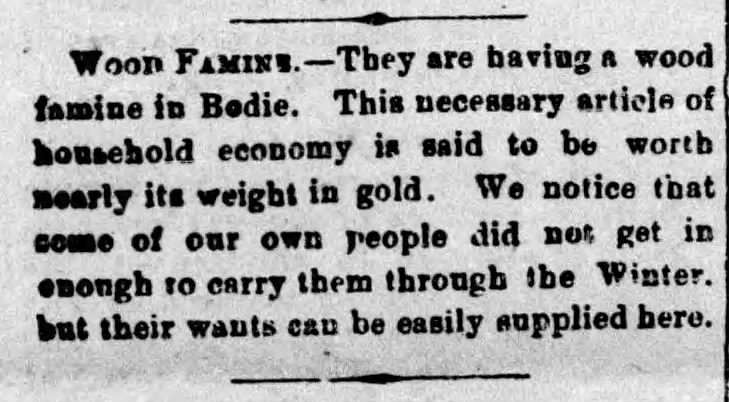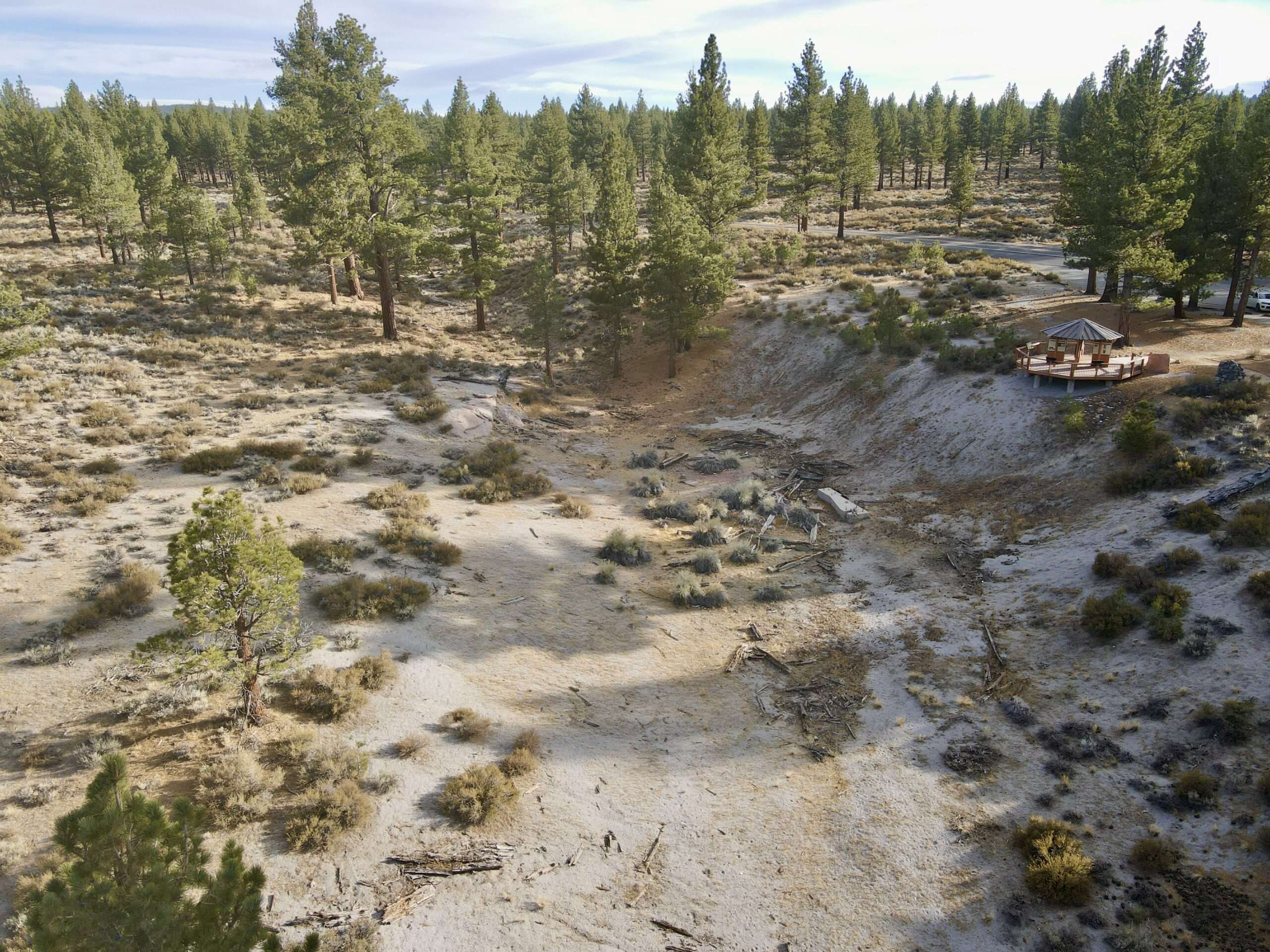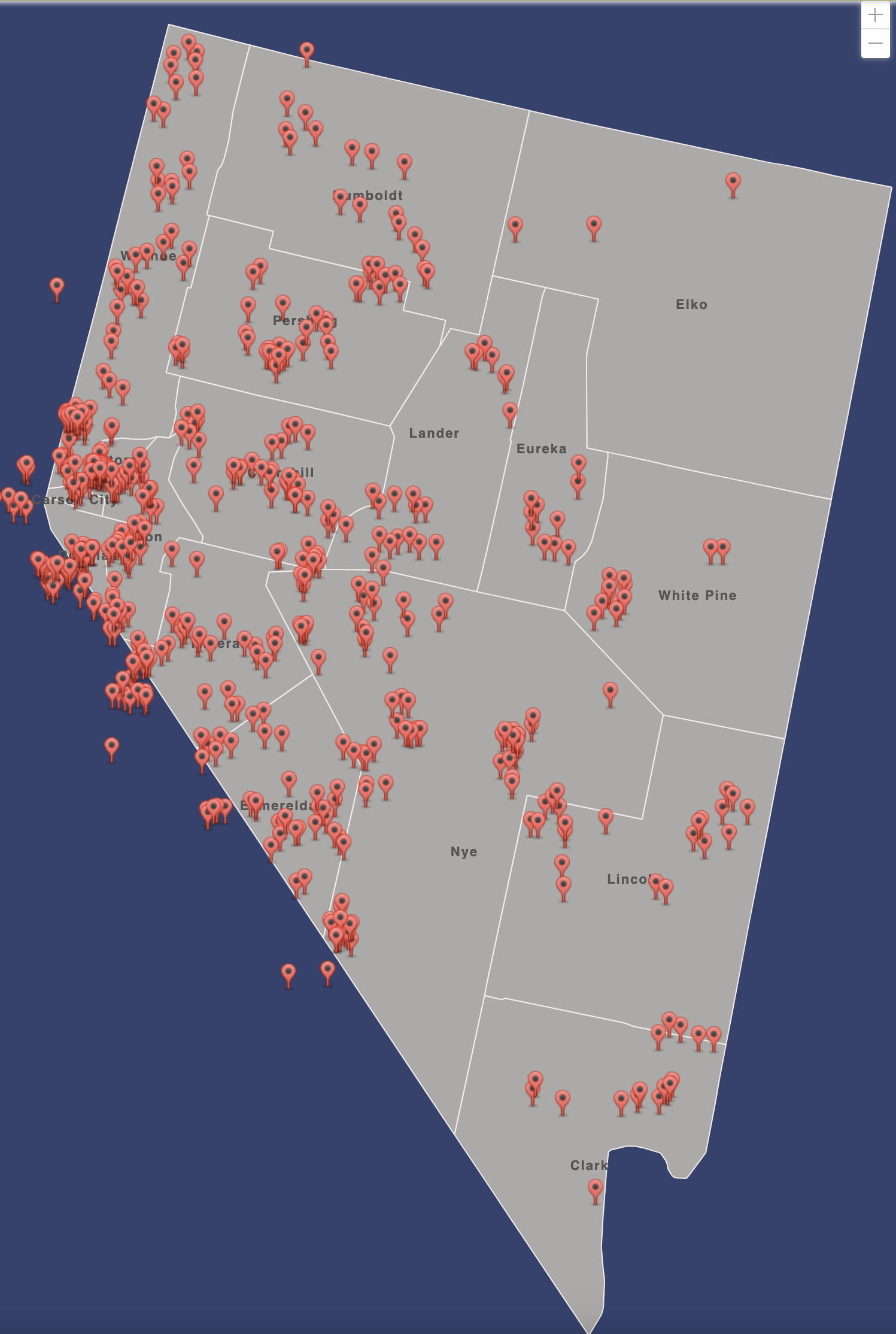Mono Mills started to meet Bodie’s insatiable need for lumber. The state-of-the-art mill and railroad operated for thirty-six years, ebbing and flowing with the mines and freeing Bodie from wood famine. Although it was a seasonal town, Mono Mills was active with daily life, including improvised medical treatments and hilarious confusion over the password for booze.

(Photo credit: Mono Mills Interpretive sign)
Emil Billeb, head of Bodie Railroad & Lumber Company, documented his time at Mono Mills, providing us with a wealth of historical information and photographs.
Bodies Wood Famine
Bodie may have been rich in gold but required other resources, including timber. The town needed lumber to build homes and businesses and support mines and fuel engines and mills.

By the fall of 1877, wood was difficult to secure and expensive. With winter approaching, “Wood” was the cry heard around town. By January 1878, Carson City was expected to fill only two-thirds of Bodies lumber orders.

Some of Bodies desperate residents stole wood from neighbors. In December 1878, one man found a way to identify the culprit and prevent future thefts.
Bang. There has been a rise in wood. A man living in the south end of town took a stick of wood lying handy on a neighbor’s pile. It burnt very well until the giant powder cartridge in the end of the wood went off. The stove and a section of the roof went with it. The wicked neighbor laughed in his sleep.
December 1878 (From Mono Mills Interpretive Sign)
In 1879-80, suppliers couldn’t keep up with the demand for wood. What was available was sold between $18 to $20 a cord ($600 in 2024), which many called extortion. Bodie consumed 5,000,000 feet of lumber a year. The mills, pumps and hoists alone required 300 cords of wood daily.

Bodie required a source of lumber, and investors turned their eyes to the Jeffery Pine trees south of Mono Lake. In 1880, opening a road to the forest ended the “wood famine.”

Mammoth Lakes, California · Saturday, January 19, 1901
Mono Saw Mill


(Photo credit: Bodie History and Bodie.com)
A group of investors from Bodie banded together, including Seth and Daniel Cool, owners of the Standard Mine; Henry Yerington, owner of the Syndicate Mine and Carson and Colorado Railroad; and Robert Graves and J.W. Haynie. They secured 12,000 acres of Jeffery timber at the southern end of Mono Lake. In 1881, they built a sawmill and community for workers. Within the year, they cut wood and made railroad ties for the soon-to-arrive railway.

Harvesting lumber

(Relocated to Lundy Lake Resort)
Two men used cross-cut saws to fell a tree and then trimmed limbs for cordwood. Pumice sand made dragging the trees challenging. Teams of six to 10 oxen, mules, and Michigan Logging Wheels transported tree trunks to loading areas. The logging wheels consist of two 10′ wheels, with the log chained between them, with the front off the ground and the back dragging. Wheelwright Silas Overpack developed the system in Michigan around 1875.

(Photo credit: Sanford Centennial Museum)
As cutting progressed into the forest, new railroad spurs were laid. Line houses dotted the rails so the workers did not have to return to Mono Mills nightly. Work stopped during winter, but some cutting occurred, as evidenced by logs cut higher up as men were standing on snow.

(Photo credit: Online Archive of California)
Mono Saw Mill

(Photo credit: Nevada Historical Society)
The foundation for the Mono Sawmill was poured in the spring of 1881 and completed in August 1881. The mill was state of the art and operated by various belt drivers. Mono Saw Mill could cut 15 million board feet and 100,00 cords of wood annually. In a 10-hour day, twenty-five mill workers cut 80,000 feet of lumber.

The mill was situated in a ravine with a second-floor level with the surrounding terrain, making it easy to unload the timber onto a saw carriage. Logs were fed into the west side of the mill, where saws cut them into planks. Leftover wood powered the boiler. Workers loaded planks onto small rail carts, which they pushed to the top of skids, where they slid into the ravine to be stacked and transported.

(Photo credit: Owens Valley History)
The mills ceased operating from 1890 to 1893 due to a downshift in Bodie’s mining. With the opening of the Green Creek Power Station in 1893, Bodie’s need for lumber decreased, and the sawmill operated at partial capacity.

(Photo credit: Mono Basin Historical Society)
Mono Mills
The settlement of Mono Saw Mill, later Mono Mills, started in 1881 with a tent town and portable sawmill. Water came from springs on Dry Creek, four and a half miles east of the mill.

(Photo credit: Owens Valley History)
The mills employed 200 men as millworkers, railroad maintenance workers, loggers, mule teamsters, cooks and laundry workers. Line houses extended into the forest as cutting progressed.

(Photo credit: Scripophily)
Families stayed at Mono Mills with their men. Lulu lived with her husband, Gus Hess, a blacksmith and mechanic. Lulu cooked for the lumber and mill workers. Their daughter, Augie Hess, was born at Mono Mills on October 23, 1914. After the men completed the work for the day, children played under the skids.

(Photo credit: Owens Valley History)
Chinese and Kutzakida Indians worked as lumbermen. They were treated the same on the job but had separate housing. Native Americans lived in wickiups.

(Photo credit: Library of Congress)
Mono Mills grew to consist of two boarding houses and 30 houses. Gilchrist, Sharp & Company operated a store, 40 mules packed wood, and two large ox teams hauled logs to the mill. Mono Mills did not have its own post office but was an extension of Bodie.
Working at Mono Mills

(Photo credit: Mono Lake Committee)
Pay varied on skill level: laborers earned $3, firemen and brakemen $4, and engineers $5 and $6 daily for the head sawyer. Everyone was expected to jump into another position and help when needed. Housing was included in their pay; three meals daily cost $1.

(Photo credit: Nevada Historical Society)
With harsh Sierra winters, only caretakers remained at Mono Mills year-round. Supplies were brought periodically via rail on trains equipped with a V snowplow on the engine.

(Photo credit: Owens Valley History)
Mono Mills and the railway ceased operations in 1917 and were sold for scrap in 1918.

(Photo credit: Owens Valley History)
Is there a doctor in the house?
While Bodie had a hospital and physicians, Mono Mills was on its own. Amazingly, no fatalities occurred with railroad construction, operation, logging, and milling. However, there were accidents and illnesses.

(Photo credit: Owens Valley History)
Emil Billeb was traveling with three companions on a spring trip to Mono Mills. The morning after their arrival, Kurt Schmidt, an emigrant from Europe, developed a headache, high fever… and worse, he hadn’t had a bowel movement in several days. Unable to return to Bodie promptly, the group called the physician in Bodie and developed a treatment plan. They believed his malady was due to impaction. Lacking medical equipment, the trio improvised an enema… using a wine siphon. A cork in a gallon demijohn created an “admirable reservoir for the occasion.”

(Photo credit: Ebay)
Gobble, gobble

In their off hours, the men enjoyed staples of any mining camp, gambling and drinking. The password for a bottle of bourbon was “turkey.”

(Photo credit: Picryl)
One fine day, a resident of Mono Mills headed to Bishop. Being a kind soul, he stopped by the store to ask the clerk if he needed anything and the man asked for a “turkey.” Several days later, the man returned and the clerk asked if he remembered his special item. As the worker returned late at night, he left his cargo in the barn. Upon opening the barn door, the storekeeper heard “gobble, gobble,” just as a turkey flew out of the barn door and into a tree. We can only hope a roast turkey dinner was compensation for missing his highly-anticipated hooch.

WANT MORE GHOST TOWNS?
For information on more than five hundred ghost towns in Nevada & California, visit the Nevada Ghost Towns Map or a list of Nevada ghost towns.

References
- Billeb, Emil W. Mining Camp Days: Bodie, Aurora, Bridgeport, Hawthorne, Tonopah, Lundy, Masonic, Benton, Thorne, Mono Mills, Mammoth, Sodaville, Goldfield. Howell North Books, 1968. Pages 45-48, 51-52, 57, 67, 70.
- Bodie: Bodie Railway
- Bodie.com
- Canton, Wanda and Richard. Bodie Railway and Lumber Company: Railroad in the sky 1881-1917. Friend of Bodie Railroad & Lumber Company. 2011. Pages 25, 26,
- Historical Marker Data Base: Mono Mills
- Mono Basin History Museum
- Mono Lake Committee
- Mono Mills to Bodie
- Owens Valley History
- Wikipedia: Mono Mills Junction
Anonymous says
That was a good story.
Tami says
Thank you, it is fun, especially with Thanksgiving.
Richard McGrew says
That was a good story.
Tami says
Thanks!
Arnie says
Thank You Tami, very interesting.
Tami says
Welcome, glad you enjoyed it!
bob h says
Thanks again Tami, Bodi and it’s hills are amazing.
Have you heard of the avalanche at the Jordan powerplant that supplied electricity to Bodie?
That’s quite a story!
Tami says
I have a huge list of places to explore in Mono Basin and it keeps growing!
Jordan was one of my early articles and other than Bodie my first ghost town in Mono. I updated the article not long ago. I uncovered more information by doing a deep dive into the history of the area and might update it again. I learned a cat survived the avalanche itself, not sure about the winter, and that the woman worked for the power company after he recovery.
https://nvtami.com/2020/08/12/jordan-california/
Vicki J says
Outrageous stories here!! 😲 Wild Turkey huh! I’m very impressed with the Bodi Story! Thank you Vicki J 😊☺️
Tami says
I’m finding a ton of stories around Mono Basin that make Bodie look tame! Robberies, kidnappings, rapes, murders and more.